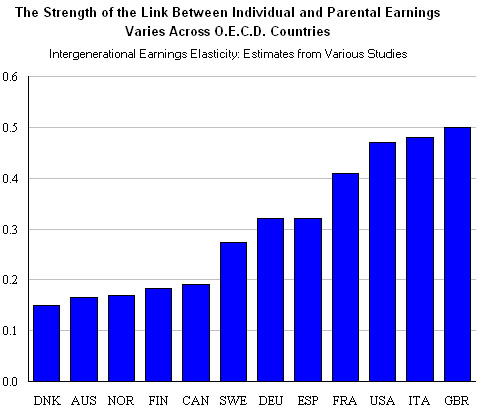Katrin sent us a great figure comparing the rate of socioeconomic mobility across several OECD nations. Using educational attainment and income as measures, the value (between zero and one) indicates how strongly parental socioeconomic status predicts a child’s socioeconomic status (a 1 is a perfect correlation and a zero would be no correlation).
 The figure shows that Great Britain, the U.S., and Italy have a near 50% correlation rate. So, in these countries, parents status predicts about 50% of the variance in children’s outcomes. In contrast, Denmark, Australia, Norway, Finland, and Canada have much lower correlations. People born in the countries on the left of this distribution, then, have higher socioeconomic mobility than people born in the countries on the right. Merit, presumably, plays a greater role in your educational and class attainment in these cases.
The figure shows that Great Britain, the U.S., and Italy have a near 50% correlation rate. So, in these countries, parents status predicts about 50% of the variance in children’s outcomes. In contrast, Denmark, Australia, Norway, Finland, and Canada have much lower correlations. People born in the countries on the left of this distribution, then, have higher socioeconomic mobility than people born in the countries on the right. Merit, presumably, plays a greater role in your educational and class attainment in these cases.
Source: The New York Times.
Lisa Wade, PhD is an Associate Professor at Tulane University. She is the author of American Hookup, a book about college sexual culture; a textbook about gender; and a forthcoming introductory text: Terrible Magnificent Sociology. You can follow her on Twitter and Instagram.
















